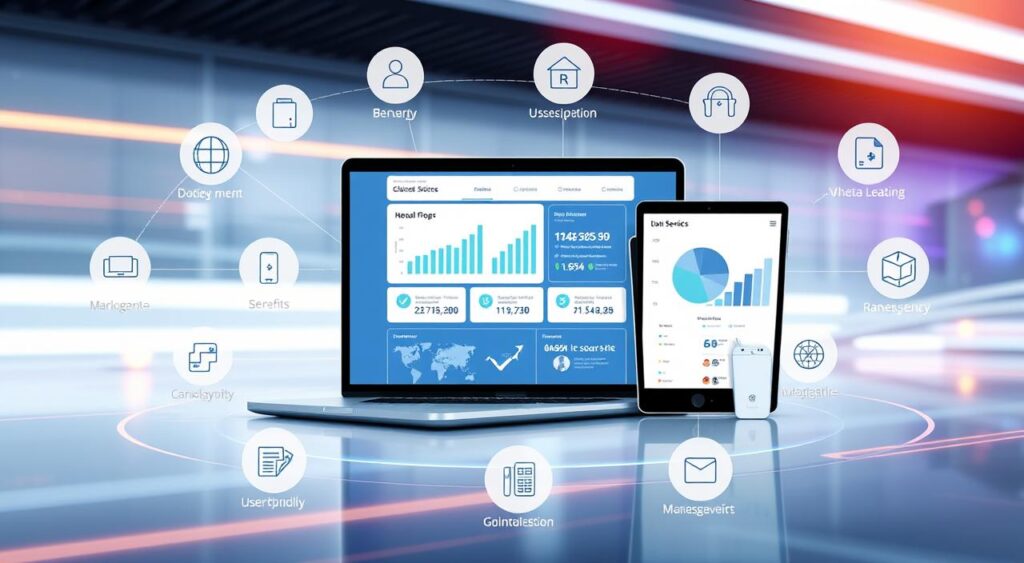Did you know the Social Security Administration handles over 6 million disability claims yearly? It takes about 200 to 230 days to process them. But, the agency does more than just handle disability claims. It provides vital benefits and services to millions of Americans through various programs. This includes retirement benefits and Medicare, aiming to offer a strong social safety net that adapts to public needs.
Planning for retirement or dealing with disability benefits? The Social Security Administration has you covered. It offers a wide range of services, from retirement planning to Medicare enrollment. With local offices, online tools, and a team of representatives, the agency works hard to make it easy to access these benefits.
Key Takeaways:
- The Social Security Administration provides a wide range of benefits, including retirement, disability, and Medicare coverage.
- Disability applications can take up to 230 days to process on average, while retirement and Medicare decisions are typically received within 30 days.
- The agency offers a variety of online tools and in-person services to help individuals navigate the complex world of Social Security benefits.
- Social Security office hours are from 8:00 a.m. to 7:00 p.m. local time, Monday through Friday, with shorter wait times in the morning, later in the week, and later in the month.
- Automated telephone services and TTY services are available for those who need them.
Overview of Social Security Administration Programs
The Social Security Administration (SSA) manages many programs for Americans. These include retirement, disability benefits, and Medicare services. They also offer Supplemental Security Income (SSI) to meet different needs.
Federal Insurance Programs
The SSA runs two main insurance programs: Social Security Disability Insurance (SSDI) and Supplemental Security Income (SSI). Both use the same medical standards for disability. But, they have different financial rules.
SSDI is for those who have worked and paid into the Social Security trust fund. SSI helps those with low income and few resources.
Supplemental Security Income (SSI)
SSI gives money to seniors and disabled people with little income. To qualify, you must pass a financial check. This includes your living situation and what you own.
The goal of SSI is to ensure a basic standard of living for those who qualify.
Medicare Services
The SSA also manages Medicare, which offers health insurance to eligible people. This includes those 65 and older, and some disabled individuals. Medicare has different parts to cover various healthcare needs.
The Social Security Administration is key in supporting the financial security of millions.
Understanding Retirement Benefits
Social Security retirement benefits are key for financial security for many Americans. About 180 million people work in jobs covered by Social Security in 2023 and pay taxes. Around 67 million people get monthly Social Security benefits, with 52 million being retirees and their families.
To get Social Security retirement benefits, you need 40 credits, which is 10 years of work, if you were born in 1929 or later. The amount you get depends on your earnings and when you start taking it. Benefits range from 78% for low earners to 28% for high earners if you start at full retirement age in 2023.
Full retirement age for Social Security benefits is between 66 and 67 years old, based on when you were born. You can get reduced benefits at 62, but they’ll be less if you claim before full retirement age. If you wait beyond full retirement age, your monthly payment can increase by up to 8% for each year, up to age 70.
Working while getting Social Security benefits might change how much you get, based on your age and earnings. Also, family members like spouses, children, and former spouses might get benefits based on the primary beneficiary’s Social Security.
| Benefit Replacement Percentage | Earnings Level |
|---|---|
| 78% | Very Low |
| 28% | Maximum |
Knowing how to get Social Security retirement benefits, how they’re calculated, and what can affect them helps you plan for the future.
Disability Benefits and Eligibility Requirements
The Social Security Administration has two programs for disability benefits: Social Security Disability Insurance (SSDI) and Supplemental Security Income (SSI). To get SSDI, you must have a disability that stops you from working for at least 12 months. It takes about 6 to 8 months to apply.
Types of Disability Programs
- Social Security Disability Insurance (SSDI) helps those who have worked and paid Social Security taxes for 20 of the last 40 quarters.
- Supplemental Security Income (SSI) is for people with little income and resources, no matter their work history.
Application Process
Applying for disability involves sending in medical records and work history. The Social Security Administration checks five steps to see if you qualify. They look at if you can work and if your condition is severe enough.
Medical Requirements
To get disability benefits, you need a serious medical condition that lasts at least 12 months. The Listing of Impairments lists specific medical conditions that might qualify. They check how severe and long-lasting your condition is.
Keep in mind, only total disability gets benefits; partial or short-term disability does not. Some special rules apply, like for blindness, survivors, children, and disabled adult children.
Social Security Cards and Number Services
The Social Security Administration (SSA) helps you get and replace social security cards. You can often get a new card online through your my Social Security account. Sometimes, you need to visit a local SSA office for a new card or changes. Your social security number tracks your earnings and helps figure out your benefits.
The SSA gives out three kinds of social security cards. The type you get depends on your citizenship and work status. You’ll need to show original or certified documents to prove who you are, how old you are, and your citizenship or immigration status. You should get your social security card in 7-10 business days after applying.
People 12 and older must have an in-person interview for a new social security number (SSN). It’s best to apply for a child’s SSN at birth to start their social security record early. If your name changes, you can update your social security records.
Employers send Form W-2 each year to check your info against the SSA’s records. You can get a free replacement social security card if it’s lost or stolen, but there are limits. Always keep your SSN private to avoid identity theft.
The SSA doesn’t share how many adult foreign-born U.S. citizens need corrected social security cards after name changes. But, it’s important to tell the SSA about any name changes to avoid mistakes in your wage records. The documents you provide must be current and not expired.
The SSA accepts many documents to prove U.S. citizenship, like a U.S. passport or Certificate of Naturalization. For name changes, you’ll need a marriage certificate, divorce decree, or court order. If your documents aren’t enough, you might need more, especially if the name change was over two years ago (or four for those under 18).
The SSA takes many identity documents, including U.S. driver’s licenses or state-issued non-driver ID cards. If you don’t have these, they might accept employee ID cards, school ID cards, or health insurance cards. They also issue non-work social security numbers under special rules for other purposes.
For non-citizens, the SSA accepts immigration documents like the I-551 Permanent Resident Card. F-1 students need a letter from a school official and employment confirmation. J-1 students require a letter from their sponsor. Lawfully admitted non-citizens can use certain services without a social security number, like banking or school registration.
Medicare Enrollment and Coverage Options
Medicare is a federal health insurance program run by the Social Security Administration. It covers millions of Americans. Knowing the enrollment periods and coverage options is key for those turning 65 or needing healthcare benefits.
Part A and Part B Coverage
Medicare Part A, or hospital insurance, is free for those 65 and older who have worked and paid Medicare taxes for 10 years. Those under 65 might qualify if they’ve received SSDI benefits for 24 months or have certain medical conditions. If eligible for Part A, you can also enroll in Part B by paying a monthly premium.
Medicare Advantage Plans
Medicare Advantage Plans, or Part C, are from private companies. They offer more than basic Part A and Part B benefits. These plans might include prescription drugs, vision, and dental, lowering costs for those who enroll.
There are different Medicare Advantage Plans, like HMOs, PPOs, and SNPs. You can sign up during your Initial Enrollment Period or the annual Medicare open enrollment from October 15 to December 7.
Prescription Drug Coverage
Prescription drug coverage, or Part D, is available as a separate plan or in some Medicare Advantage Plans. Those with Original Medicare (Part A or Part B) can get Part D, except for those with a Medicare PFFS plan. It’s important to enroll in a Part D plan during the Initial Enrollment Period or the annual open enrollment to avoid penalties.
The Social Security Administration offers many resources for navigating Medicare enrollment and coverage options. By understanding eligibility, enrollment periods, and plan types, Medicare beneficiaries can choose the best coverage for their healthcare needs.
Online Services and Digital Access
The Social Security Administration (SSA) has a lot of online services. You can manage your Social Security benefits and personal info easily through their website and the my Social Security account.
To use the my Social Security account, you must be 18 or older and have a valid Social Security number (SSN). You can sign up on the SSA website or through services like Login.gov or ID.me. If you have a security freeze or fraud alert, you might need to lift it to create your account.
The my Social Security account lets you do many things. You can apply for benefits, check your application status, and even request a replacement card. The SSA keeps adding more online services to give you more control over your Social Security.
People living abroad can use ID.me to access many SSA services. This means you can still use online services no matter where you are. But remember, your my Social Security account is for your eyes only. Never let anyone else use it.

The SSA takes keeping your info safe very seriously. They want you to protect your my Social Security account. Be careful of phishing scams and fake websites that look like the SSA’s. Real SSA emails come from places like no-reply@ssa.gov or ThankYou@ssa.gov. Any links will take you to ssa.gov.
Calculating Your Benefits
The Social Security Administration has tools to help you guess your future retirement benefits. The Retirement Estimator uses your Social Security earnings to give you a personalized benefit estimate. This online tool is updated regularly, with the latest update in August 2024. It can predict benefits from 1951 to 2023, and even for 2024 and beyond if you enter expected earnings.
Benefits Formula
Your Social Security benefits are based on your highest 35 years of earnings, adjusted for inflation. The Average Indexed Monthly Earnings (AIME) is found by adding your highest indexed earnings and dividing by the number of months in those years. The Primary Insurance Amount (PIA) formula uses bend points that change every year. For 2025, the bend points are $1,226 and $7,391.
For example, someone retiring at 62 in 2025 with an AIME of $13,689 would get a PIA of $4,020.90.
Cost of Living Adjustments
Your Social Security benefits get Cost of Living Adjustments (COLAs) each year to keep up with inflation. These adjustments help your benefits keep their value over time, ensuring they match the rising cost of living.
| Retirement Benefit Factors | Details |
|---|---|
| Early Retirement Reduction | Retirement benefits can be reduced by up to 30% if claimed before the normal retirement age of 62. |
| Delayed Retirement Credits | Delayed retirement credits gradually increase to 8% per year for those born after 1942, but no credits are given after age 69. |
| Disability Benefit Reductions | Benefits for disabled workers and their families may be reduced if they receive certain public disability benefits like Workers’ Compensation. |
By using the Social Security Administration’s benefit calculators, you can plan better for retirement. These tools and resources are great for anyone, whether you’re just starting your career or nearing retirement.
Social Security Taxes and Contributions
The Social Security program gets most of its money from payroll taxes, also known as FICA taxes. Both workers and their employers pay these taxes. Self-employed folks pay both sides themselves. The Social Security Administration sets the tax rate and how much you can earn before you stop paying taxes each year.
These taxes do two main things. They help pay for the benefits going to those who are currently receiving them. They also add to your earnings record, which helps figure out how much you’ll get in Social Security benefits later.
Figuring out if you have to pay taxes on your Social Security benefits can be tricky. It depends on your filing status, how much you make, and how much you get in benefits. You should check IRS Publication 915 for more information on what part of your benefits might be taxed.
The U.S. has agreements with other countries to avoid double taxing the same work. This means you only pay Social Security taxes in one country. Also, non-resident aliens might not have to pay self-employment tax. But, they could start paying it if they become U.S. resident aliens.
It’s key to understand how Social Security taxes and contributions work. This helps you plan for your future and make sure you’re paying the right amount to get Social Security benefits. By keeping up with tax rates, earnings limits, and rules, you can make the most of your contributions and get the best retirement benefits.
Understanding Full Retirement Age
The full retirement age, also known as the normal retirement age, is when you can get your full Social Security retirement benefits. This age changes based on when you were born. It goes from 66 for those born between 1943-1954 to 67 for those born in 1960 and later.
Early Retirement Options
You can retire as early as 62, but your benefits will be less. The cut in benefits for starting at 62 varies. It’s 25.00% for those born between 1943-1954 and 30.00%-35.00% for those born in 1960 and later. Also, the spouse’s benefit drops by about 30.00%-35.00% for those born in 1960 and later when they start at 62.
Delayed Retirement Credits
If you wait to retire beyond your full retirement age, you might get delayed retirement credits. These can boost your monthly benefit up to age 70. Knowing about early and delayed retirement options helps you decide when to claim your Social Security benefits.
| Year of Birth | Full (Normal) Retirement Age | Percentage Reduction at Age 62 | Spouse Benefit Reduction at Age 62 | Maximum Spouse Benefit | Delayed Retirement Credits |
|---|---|---|---|---|---|
| 1943-1954 | 66 | 25.00% | 30.00%-35.00% | 50% | Increase up to age 70 |
| 1960 and later | 67 | 30.00%-35.00% | 30.00%-35.00% | 50% | Increase up to age 70 |

It’s key to apply for Medicare within 3 months of turning 65, even if you delay Social Security. By understanding full retirement age, early retirement, and delayed retirement credits, you can choose the best time to start getting your Social Security benefits.
Survivor and Family Benefits
The Social Security Administration offers important benefits to those who have lost a loved one. These benefits help the family of workers who have retired or become disabled. To get these benefits, you must have a connection to the worker and meet certain income requirements.
Surviving spouses can start getting benefits at 60, or 50 if they’re disabled. Kids under 18 (or 19 if in school full-time) and those with disabilities before 22 can also get help. Parents aged 62 or older might get benefits if the worker helped support them.
Divorced spouses who were married for at least 10 years and are 60 or older (or 50-59 if disabled) can also get benefits. There’s a one-time payment of $255 if the worker had worked enough and met specific rules.
Surviving spouses can get 71% to 100% of the worker’s benefit, based on their age and situation. Children and other family members can get 150% to 180% of the worker’s benefit each month. Remember, pensions from jobs not covered by Social Security might affect your benefits.
| Beneficiary | Benefit Eligibility | Benefit Amount |
|---|---|---|
| Surviving Spouse | As early as age 60 (or 50 if disabled) | 71% to 100% of worker’s basic benefit |
| Surviving Divorced Spouse | Age 60 or older (or 50-59 if disabled), from a marriage lasting at least 10 years | 71% to 100% of worker’s basic benefit |
| Children | Under age 18 (or up to 19 if full-time student), or any age if disabled before 22 | 150% to 180% of worker’s benefit |
| Dependent Parents | Age 62 or older, if worker supported at least half their financial needs | Varies based on individual circumstances |
The Social Security Administration provides many resources to help claim survivor and family benefits. It’s crucial to know the rules and report any changes to get your benefits correctly.
In 2021, the Social Security Administration gave out $2.8 billion in benefits to 4 million kids of retired, deceased, or disabled parents. These benefits are a big help to families in tough times, ensuring their well-being.
To find out more about survivor and family benefits, visit the Social Security Administration’s website or talk to a representative. Knowing what’s available can help you get the support you need during hard times.
Social Security Administration Service Hours and Locations
The Social Security Administration (SSA) offers many services to the public. You can access them online or in person. Whether you need to apply for benefits or replace a lost card, the SSA has you covered.
Online Resources
The SSA’s website, www.socialsecurity.gov, is open 24/7. Here, you can find lots of information and request services. You can even manage your account online.
In-Person Services
The SSA also has local field offices across the country. These offices are open from 9 a.m. to 4 p.m., Monday to Friday. Some offices close early on Wednesdays.
To book an appointment, call the SSA’s toll-free number at 1-800-772-1213. It’s open from 7 a.m. to 7 p.m., Monday to Friday. For those who are deaf or hard of hearing, there’s a TTY-TDD number at 1-800-325-0778.
Whether you like online services or prefer a face-to-face visit, the SSA is here for you. With offices nationwide and a strong online presence, the SSA makes it easy to get the help you need.
Supplemental Security Income Requirements
Supplemental Security Income (SSI) is a federal program. It helps people with little income and resources who are old, blind, or disabled. To get SSI, you must meet certain criteria like financial need and disability status.
To qualify, your countable resources can’t be more than $2,000 if you’re single or $3,000 if you’re married. Since August 22, 1996, most non-citizens need to meet specific rules to get SSI. But, there are exceptions for some, like human trafficking victims and certain Afghan and Iraqi nationals.
SSI won’t help if you have unsolved felony or arrest warrants. Being in jail also affects your eligibility. You can’t get SSI for a month if you’re in a public institution, except for homeless shelters. Also, if you sell things for less than they’re worth to qualify, you might not get SSI.
The monthly SSI payment for 2024 is $943 for one person and $1,415 for a couple. You can’t have more than $2,000 in resources if you’re single or $3,000 if you’re married. You can apply online for SSI for some people. You might also get benefits from programs like SNAP and Medicaid.
The rules for SSI can change based on where you live. Different states have different rules.
| Eligibility Requirement | Details |
|---|---|
| Resources Limit | $2,000 for an individual/child, $3,000 for a couple |
| Non-Citizen Requirements | Must meet specific criteria for qualified aliens, with exceptions for certain individuals |
| Incarceration and Felony Warrants | Ineligible for a full calendar month in public institutions, except for emergency shelters; no benefits for unsatisfied felony warrants |
| Resource Transfers | Individuals who give away or sell resources below their actual value to meet SSI requirements may be deemed ineligible |
| 2024 Monthly Payments | $943 for one person, $1,415 for a couple |
Appeals Process and Rights
If you disagree with a decision by the Social Security Administration (SSA), you can appeal. The appeals process has several steps: reconsideration, a hearing by an administrative law judge, Appeals Council review, and Federal Court review. Each step has its own rules and time limits.
Hearing Process
The hearing process starts with a request for a hearing before an administrative law judge. You have 60 days to appeal after getting a written notice of the initial decision, for both non-medical and medical disability cessation. If you don’t appeal within 10 days, your payments might decrease until the reconsideration is done.
There’s a 75-day notice before a hearing date if you request one. You can ask for a subpoena 10 business days before the hearing, with specific rules. The SSA might cover travel costs if the hearing is over 75 miles away.
New evidence must be in by five business days before the hearing. If you ask for benefits to continue within 10 days of the notice, they can keep going until a new decision is made. The judge decides if subpoenas are needed for documents or witnesses.
Appeals Council Review
If you’re not happy with the judge’s decision, you can ask for an Appeals Council review. The SSA handles over half a million hearing and appeal decisions every year. They aim to cut the wait time for hearings to 270 days by 2021.
Congress gave $290 million to help reduce the backlog. Since 2016, nearly 600 ALJs have been hired. In 2018, over 500 decision writers and 170 support staff were added. The number of pending requests has gone down each month since January 2017.
As of March 2019, about 720,000 people were waiting for a hearing decision.
Throughout the appeals process, you can have a representative. The SSA helps you find qualified ones to help you.
Multilingual Services and Resources
The Social Security Administration (SSA) works hard to help everyone, no matter their language. They have over 2,950 staff who speak more than 47 languages. These employees are all over the country, helping people in many languages.
The SSA has a plan to make sure everyone can get the help they need, no matter their English skills. This plan shows their dedication to fairness and inclusion. They offer free language help, so everyone can get the most out of SSA services.
The SSA’s website is also available in 15 languages through the Multilingual Gateway. This helps the 25 million people in the U.S. who speak a foreign language at home. With these resources, everyone can get the help they need, just like those who speak English.







